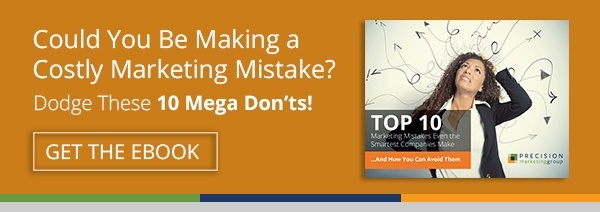Does your business sell to other businesses? That means you’re in B2B marketing. Selling directly to consumers? Well, that’s B2C.
Relying on peer-to-peer endorsements? Then P2P is your jam. Oh, and if your business markets to government agencies, there’s a name for that, too: B2G.
For marketers, these classifications are appointed with good intent; they’re designed to help us qualify our marketing audiences so we can “get to know” them better and adhere to marketing best practices accordingly.
But there’s a common and arguably better thread that unifies those audiences: and it’s called H2H.
What is H2H and why does it matter?
H2H marketing, or human-to-human marketing, represents the concept that behind every business, consumer, non-profit, or government body, there is a living, breathing human being who is making decisions about your company.
We tend to get away from this fact—especially in today’s highly digitized marketing era where bots, Artificial Intelligence, and other forms of machine learning prevail.
But now more than ever, implementing that “human” element can be a huge differentiator for businesses in the crowded and often impersonal online space.
Humanizing your marketing builds trust. It taps into people’s emotions—and research shows that this is one of the most important elements in the decision-making process of the buyer’s journey.
So what are some ways to apply H2H marketing?
There is no predefined checklist of H2H marketing practices that you can follow verbatim.
Rather, H2H is more of a blanket term that can be applied across the board and, better yet, is likely to touch on many of the marketing strategies that you're already using.
Here are five great ways you can think about your marketing through an H2H lens.
1. Talk like an actual person.
Marketing expert and two-time author Bryan Kramer, who has championed the H2H movement, says it best when he encourages businesses to “stop trying to be perfect and talk like an actual human.”
Kramer concedes that we often write more formally than we speak. When it comes to the actual words you’re using to describe your business, striving for perfection can quickly become your Achilles heel.
Read through your website. Are you using “easy” words and phrases that you would use while talking to someone face to face?
Keep in mind, that over-engineered, robotic language is not believable and resonates with no one.
Research shows that it actually triggers a sense of risk. (Read the science behind this in our related article, 5 Psychological Hacks to Inspire Your Copywriting.)
Have trouble striking the right tone? Kramer suggests simple role-play exercises.
Try explaining different areas of your business to another member of your marketing team—an exercise that can help inform the right words to use.
Remember, the easier you make things for your reader audience, the more believable and trustworthy you become.
2. Humanize your bots.
Irony at its finest, right? But here’s the deal: bots are everywhere. They’re now an established part of marketing—and that won’t change any time soon.
Consider those pop-up chatbots on a website, for example. By now, website visitors have caught on that these are indeed robots—and simply embrace them for what they are. In fact, 69% of consumers have actually come to prefer communicating with chatbots because they offer speedy answers and solutions.
Even here, an H2H mentality need still apply. Your bot doesn’t actually have to sound bot-like and impersonal.
Apply that “human” factor by using language that’s casual and conversational. Give your chatbot a name, a photo, and yes, even a playful sense of humor.
Even though your visitors know it’s a bot they’re talking to, they’ll be pleasantly reminded that there are, in fact, real humans behind the scenes.
3. Embrace your shortcomings and be “hyper transparent.”
When you put yourself in your prospects’ shoes, the digital world feels a bit one-sided. If you’re able to effectively nurture those prospects through to the sales process, they’ll finally have a chance to raise questions and concerns to the “real people” behind your business.
Too often, there are missed opportunities to do this earlier in the process (in other words, in your marketing).
As marketers, we bristle at the thought of surfacing our company’s imperfections and stick to talking about our businesses in the best possible light.
But to err is human… and buyers are wary of companies that overdo it with the pros and don't address the cons.
That’s why providing an honest, balanced view is a critical trust-builder. No product or service is right for everyone, period. And when you proactively surface your own shortcomings, you’re getting ahead of your buyers’ concerns and objections.
A great example? After a 2-year decline in sales several years ago, Dominos Pizza launched a nationwide campaign to tell everyone how bad their pizza tasted—before they made it better. This “hyper transparency” in their messaging increased YOY same-store sales by nearly 15%.
4. Use stories to become more memorable.
A customer story is the H2H antidote to a traditional sales pitch. Do you incorporate any storytelling elements into your marketing?
Think about a customer who you have helped and make him or her the protagonist of your success story. Why did that person come to you? How did you help?
Research shows that if people love your brand’s story, 55% are more likely to buy from you in the future, while 15% will buy the product immediately.
Storytelling marketing is a potent and necessary “human” element for marketers in any industry. Want ideas on how to implement it? Check out our related blog, Think Your Biz is Boring? Make Storytelling Marketing Your Secret Sauce.
5. Incorporate user-generated content (UGC).
“I believe a company’s marketing message at face value, especially when it comes directly from the source.” Said no one, ever.
Your audience is naturally skeptical of marketing claims that come straight from the source. But they ARE open to hearing the opinions of like-minded peers.
In fact, consumers are 92% more likely to trust their peers over advertising when it comes to purchasing decisions.
This makes user-generated content (UGC) a vital element for every H2H marketer’s toolbox.
And better yet, there are plenty of ways to incorporate it, from sparking conversations on social media, encouraging people to share photos of your service or solution in action, reviewing you on a third-party website, and so on. (See our related article, 5 Easy Ways to Incorporate User-Generated Content.)
We hope you find H2H marketing as interesting as we do here at Conveyor Marketing Group. Now go forth and be human with the H2H strategies you’ve learned about today!











